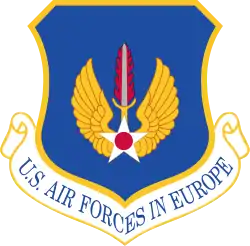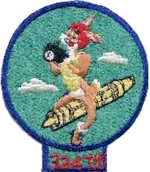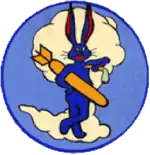324th Expeditionary Reconnaissance Squadron
The 324th Expeditionary Reconnaissance Squadron is a provisional United States Air Force unit. Its is assigned to the 409th Air Expeditionary Group at Naval Air Station Sigonella, Iitaly.
324th Expeditionary Reconnaissance Squadron
 | |
|---|---|
| Active | 1942–1945; 1947–1957; 2009; 2010; 2011– |
| Role | Reconnaissance |
| Part of | United States Air Forces Europe |
| Garrison/HQ | Naval Air Station Sigonella |
| Motto(s) | Veni Vidi vici Latin I Came, I Saw, I Conquered[1] |
| Engagements | European Theater of Operations[1] |
| Decorations | Distinguished Unit Citation Air Force Outstanding Unit Award[1] |
| Insignia | |
| 324 Expeditionary Reconnaissance Sq emblem324 Expeditionary Reconnaissance Sq emblem |  [1] [1] |
| Patch with 324th Strategic Reconnaissance Squadron emblem Approved 24 August 1953[2] |  |
| 324th Bombardment Squadron emblem[3] |  |
| World War II Tail and Fuselage Codes | Triangle A, DF |
The squadron was first activated in 1942 as the 324th Bombardment Squadron. After training in the United States, it deployed to the European Theater of Operations, where it participated in combat from late 1942 until V-E Day, earning two Distinguished Unit Citations. Following the end of the war, it returned to the United States and was inactivated in November 1945.
The unit was activated as the 324th Reconnaissance Squadron under Strategic Air Command in 1947. The following year it moved to McGuire Air Force Base and began to equip with bombers modified for long range reconnaissance. It continued in the strategic reconnaissance role until 1957, when it was inactivated.
In 2009, the squadron was converted to provisional status as the 324th Expeditionary Reconnaissance Squadron and assigned to United States Air Forces Europe to activate or inactivate as needed.
History
World War II
The squadron was established as a Boeing B-17 Flying Fortress heavy bomber squadron in early 1942. It trained under Third Air Force in the southeastern United States with final training under Second Air Force in Washington. The 324th deployed to the European Theater of Operations, where it became part of VIII Bomber Command in England. It was one of earliest American heavy bomber squadrons to arrive in England. Most personnel were demobilized in England immediately after the end of the war in Europe. The squadron returned to the United States with a small headquarters staff and was planned to be re-equipped and remanned as a Boeing B-29 Superfortress squadron. The surrender of Japan canceled these plans and it was inactivated in the United States during November 1945.
Strategic reconnaissance
The squadron was reactivated in 1947 as a Strategic Air Command long-range strategic reconnaissance squadron, although it was not manned or equipped until July 1948. It used B-17 and B-29 bombers refitted for reconnaissance missions. The squadron deployed to Japan in 1950, and performed strategic reconnaissance missions over Korea and the Northern Pacific coast of People's Republic of China and the Soviet Union. The 324th Re-equipped with RB-45C Tornado jet reconnaissance aircraft, flying reconnaissance and mapping combat missions over Korea until returning to the United States in mid-1952. The squadron re-equipped with RB-47E Stratojets and performed various reconnaissance missions on a worldwide scale until inactivation in 1957.
Provisional unit
In 2009, the squadron was converted to provisional status as the 324th Expeditionary Reconnaissance Squadron and assigned to United States Air Forces Europe to activate or inactivate as needed. It was most recently activated in the Mediterranean as part of the 409th Air Expeditionary Group.
Lineage
- Constituted as the 324th Bombardment Squadron (Heavy) on 28 January 1942
- Activated on 15 April 1942
- Redesignated 324th Bombardment Squadron, Heavy on 10 August 1943
- Inactivated on 7 November 1945
- Redesignated 324th Reconnaissance Squadron on 11 June 1947
- Activated on 1 July 1947
- Redesignated 324th Strategic Reconnaissance Squadron on 10 November 1948
- Redesignated 324th Strategic Reconnaissance Squadron, Medium on 6 July 1950
- Inactivated on 8 November 1957[4]
- Converted to provisional status, redesignated 324th Expeditionary Reconnaissance Squadron on 25 June 2009 and assigned to United States Air Forces Europe to activate or inactivate as needed[1]
- Activated on 2 July 2009[1]
- Inactivated on 9 December 2009
- Activated on 28 July 2010
- Inactivated on 1 October 2010
- Activated on 25 March 2011
Assignments
- 91st Bombardment Group, 15 April 1942 – 7 November 1945
- 91st Reconnaissance Group (later 91st Strategic Reconnaissance Group), 1 July 1947
- 91st Strategic Reconnaissance Wing, 28 May 1952 – 8 November 1957[4]
- 404th Air Expeditionary Group, 2 July 2009[1] – 9 December 2009
- 404th Air Expeditionary Group, 28 July 2010 – 1 October 2010
- attached to Seventeenth Air Force, 25 March 2011
- 409th Air Expeditionary Group, 1 March 2012
Stations
- Harding Field, Louisiana, 15 April 1942
- MacDill Field, Florida, 16 May 1942
- Walla Walla Army Air Base, Washington, c. 28 June – 24 August 1942
- RAF Kimbolton (AAF-117),[5] England, 13 September 1942 (ground echelon), early October 1942 (air echelon)
- RAF Bassingbourn (AAF-121),[5] England, 14 October 1942 – 23 June 1945
- Drew Field, Florida, 3 July – 7 November 1945
- Andrews Field, Maryland, 1 July 1947
- McGuire Air Force Base, New Jersey, 19 July 1948
- Barksdale Air Force Base, Louisiana, 1 October 1949
- Deployed to Johnson Air Base and Yokota Air Base, Japan 6 July 1950 – 28 May 1952
- Lockbourne Air Force Base, Ohio, 11 September 1951 – 8 November 1957[4]
- Ramstein Air Base, Germany, 2 July 2009[1] – 9 December 2009
- Naval Station Rota, Spain, 28 July 2010 – 1 October 2010
- Naval Air Station Sigonella, Sicily, Italy. 25 March 2011
Aircraft
- Boeing B-17 Flying Fortress, 1942–1945
- Boeing RB-17 Flying Fortress, 1948–1949
- Boeing RB-29 Superfortress, 1949–1950
- North Americal RB-45 Tornado, 1950–1953
- Boeing RB-47E Stratojet, 1953–1957[4]
See also
References
Notes
- Robertson, Patsy (10 May 2017). "Factsheet 324 Expeditionary Reconnaissance Squadron (USAFE)". Air Force Historical Research Agency. Retrieved 8 August 2017.
- Maurer, Combat Squadrons, pp. 398–399
- Watkins, pp. 34–35
- Lineage, including assignments, stations and aircraft through 1957 in Maurer, Combat Squadrons, pp. 398–399
- Station number in Anderson
Bibliography
![]() This article incorporates public domain material from the Air Force Historical Research Agency website http://www.afhra.af.mil/.
This article incorporates public domain material from the Air Force Historical Research Agency website http://www.afhra.af.mil/.
- Anderson, Capt. Barry (1985). Army Air Forces Stations: A Guide to the Stations Where U.S. Army Air Forces Personnel Served in the United Kingdom During World War II (PDF). Maxwell AFB, AL: Research Division, USAF Historical Research Center. Archived from the original (PDF) on 4 March 2016. Retrieved 7 July 2012.
- Maurer, Maurer, ed. (1983) [1961]. Air Force Combat Units of World War II (PDF) (reprint ed.). Washington, DC: Office of Air Force History. ISBN 0-912799-02-1. LCCN 61060979.
- Maurer, Maurer, ed. (1982) [1969]. Combat Squadrons of the Air Force, World War II (PDF) (reprint ed.). Washington, DC: Office of Air Force History. ISBN 0-405-12194-6. LCCN 70605402. OCLC 72556.
- Ravenstein, Charles A. (1984). Air Force Combat Wings, Lineage & Honors Histories 1947–1977. Washington, DC: Office of Air Force History. ISBN 0-912799-12-9.
- Watkins, Robert (2008). Battle Colors: Insignia and Markings of the Eighth Air Force in World War II. Vol I (VIII) Bomber Command. Atglen, PA: Shiffer Publishing Ltd. ISBN 0-7643-1987-6.



.svg.png.webp)